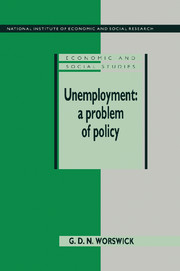Book contents
- Frontmatter
- Contents
- List of tables
- List of charts
- Preface
- 1 INTRODUCTION
- 2 CONCEPTS AND MEASUREMENTS
- PART 1 STRUCTURAL CHANGE
- PART 2 THE WAGE QUESTION
- PART 3 MACROECONOMIC POLICY
- 12 THE THEORETICAL BACKGROUND
- 13 EVIDENCE RELATING TO THE ECONOMY
- 14 EVIDENCE RELATING TO POLICY
- 15 REFLECTIONS ON MACROECONOMIC POLICY
- PART 4 INTERNATIONAL DIMENSION
- Appendix to Chapter 8: The puzzle of the apparent fall in United States real wages
- Notes
- List of works cited
- Index
- THE NATIONAL INSTITUTE OF ECONOMIC AND SOCIAL RESEARCH PUBLICATIONS IN PRINT
13 - EVIDENCE RELATING TO THE ECONOMY
from PART 3 - MACROECONOMIC POLICY
Published online by Cambridge University Press: 06 July 2010
- Frontmatter
- Contents
- List of tables
- List of charts
- Preface
- 1 INTRODUCTION
- 2 CONCEPTS AND MEASUREMENTS
- PART 1 STRUCTURAL CHANGE
- PART 2 THE WAGE QUESTION
- PART 3 MACROECONOMIC POLICY
- 12 THE THEORETICAL BACKGROUND
- 13 EVIDENCE RELATING TO THE ECONOMY
- 14 EVIDENCE RELATING TO POLICY
- 15 REFLECTIONS ON MACROECONOMIC POLICY
- PART 4 INTERNATIONAL DIMENSION
- Appendix to Chapter 8: The puzzle of the apparent fall in United States real wages
- Notes
- List of works cited
- Index
- THE NATIONAL INSTITUTE OF ECONOMIC AND SOCIAL RESEARCH PUBLICATIONS IN PRINT
Summary
MONEY, VELOCITY, PRICES AND OUTPUT
Evidence about how the economy works can be usefully considered under headings suggested by the discussion of MV = PT, and we begin with the question which was at the centre of the original monetarist view of the world, namely whether or not the demand for money was stable. Suppose, to take the simplest case, we could show that the demand for money, that is, the amount of money people wished to hold, depended on their level of income, and upon nothing else, we should be home and dry. For, if the authorities chose to increase the supply of money, of which, let us assume, they have the monopoly, then the level of money income would have to rise accordingly.
Brown (1985) has recently examined the statistical evidence of the relations between variables in the quantity of money equation for a number of countries, including all the main industrial countries, over the period 1950–79. To start with, he looks at the closeness of association between pairs of the variables. He uses a particular form of the Fisher equation, MV = PQ where Q, stands for real income, rather than the T used earlier, which stood for all transactions. This choice is quite legitimate, since the definition of V, the velocity of circulation, is complementary to Q. Q is an index number, and there is also a complementary index number of prices such that PQ = Y the nominal national income.
- Type
- Chapter
- Information
- Unemployment: A Problem of PolicyAnalysis of British Experience and Prospects, pp. 144 - 151Publisher: Cambridge University PressPrint publication year: 1991

